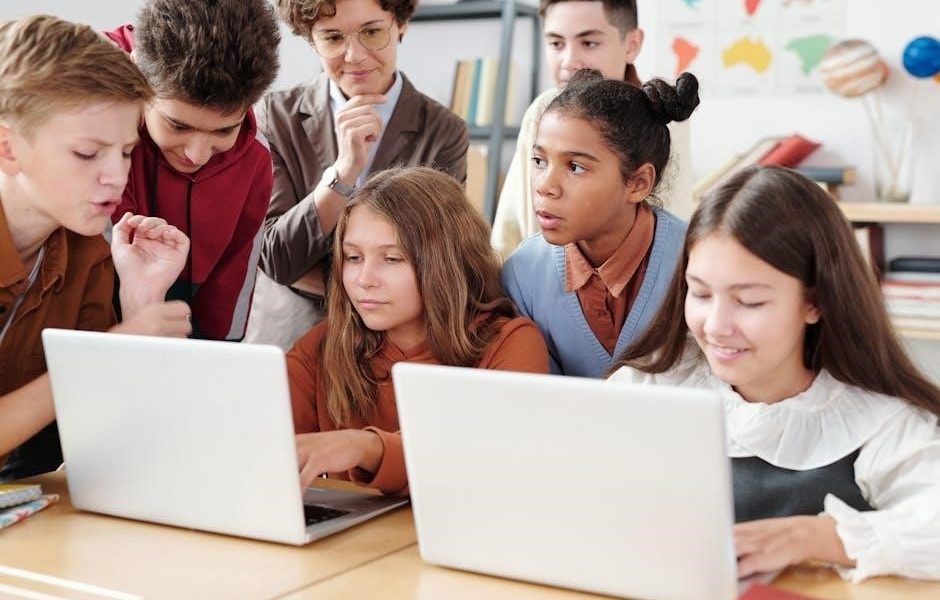The kindergarten curriculum is a comprehensive program designed to foster young children’s overall development through play-based learning, social-emotional growth, and foundational skills in math, literacy, science, and arts, preparing them for future academic success.
1.1 Importance of Early Childhood Education
Early childhood education is crucial for fostering cognitive, social, and emotional development in young children. It laying the foundation for lifelong learning by introducing basic skills, creativity, and social-emotional growth, preparing them for future academic and personal success. Research highlights its role in improving readiness, reducing achievement gaps, and promoting confidence and curiosity. Engaging experiences during these formative years shape a child’s ability to adapt, collaborate, and thrive in diverse environments, making it a cornerstone of their educational journey and future opportunities.
1.2 Overview of Key Learning Areas
The kindergarten curriculum encompasses a variety of learning areas designed to promote holistic development. Key areas include language and literacy, mathematics, science, social studies, arts, and physical education. These subjects are integrated through play-based activities, hands-on experiences, and interactive learning. The curriculum also emphasizes social-emotional growth, creativity, and critical thinking. By fostering curiosity and exploration, it prepares children for a lifelong journey of learning, ensuring they develop essential skills and confidence to succeed in school and beyond.
Social-Emotional Development
Social-emotional development focuses on helping children build self-awareness, self-regulation, and interpersonal skills. Teachers guide kids in resolving conflicts, cooperating with peers, and understanding emotions, fostering a supportive environment.
2.1 Skills Development
Social-emotional skills development in kindergarten focuses on teaching children cooperation, communication, and emotional intelligence. Educators guide kids in understanding and managing emotions, empathy, and self-awareness. Activities like group work, storytelling, and role-playing help build these skills. Teachers also encourage independence, problem-solving, and conflict resolution. These foundational abilities are crucial for building strong relationships and preparing children for academic and personal success.
Skills like sharing, taking turns, and expressing feelings are emphasized, fostering a supportive and inclusive classroom environment.
2.2 Conflict Resolution
Conflict resolution in kindergarten is taught through encouraging open communication, empathy, and understanding. Teachers guide children to express their feelings calmly and listen to others’ perspectives. Role-playing activities and group discussions help kids develop problem-solving skills. By fostering cooperation and mutual respect, educators empower children to resolve disagreements peacefully. These strategies help create a harmonious classroom environment and equip young learners with essential life skills for navigating social interactions confidently and respectfully.
2.3 Emotional Intelligence
Emotional intelligence in kindergarten focuses on helping children recognize, understand, and manage their emotions. Teachers use activities like feeling charts, stories, and role-playing to teach empathy and self-awareness. Children learn to identify emotions in themselves and others, developing healthy ways to express and regulate feelings. This foundation supports social interactions, friendships, and long-term emotional well-being, fostering a positive and supportive classroom environment for young learners to thrive emotionally and academically.

Math Skills
Math skills in kindergarten are vital for developing problem-solving abilities, introducing foundational concepts through playful, interactive activities that encourage curiosity, logical thinking, and creativity in young learners.
3.1 Number Sense
Number sense in kindergarten focuses on recognizing numbers up to 10, understanding sequences, and comparing quantities. Activities include counting games, number tracing, and matching to build foundational math skills. Songs and visual aids help children grasp basic number relationships, fostering an intuitive understanding of numerals and their meanings. This skill is crucial for arithmetic and problem-solving, laying the groundwork for future math abilities through engaging, hands-on experiences.
3.2 Counting and Basic Operations
Counting and basic operations introduce children to fundamental math concepts. Activities focus on counting beyond 10, grouping objects, and understanding “one-to-one correspondence.” Basic addition and subtraction are explored through play, using manipulatives like blocks or counters. Visual aids and rhymes help reinforce these skills, ensuring children grasp the relationship between numbers and quantities. This builds a strong foundation for arithmetic and logical thinking, fostering confidence in problem-solving and math exploration.
3.3 Shapes and Patterns
Recognizing shapes and patterns is a cornerstone of early math education. Kindergartners learn to identify basic shapes like squares, circles, and triangles, exploring their properties through tactile activities. Patterns are introduced using objects, colors, and movements, encouraging children to predict and extend sequences. These skills enhance spatial awareness, logical thinking, and problem-solving abilities, laying the groundwork for geometry and math reasoning in later years.
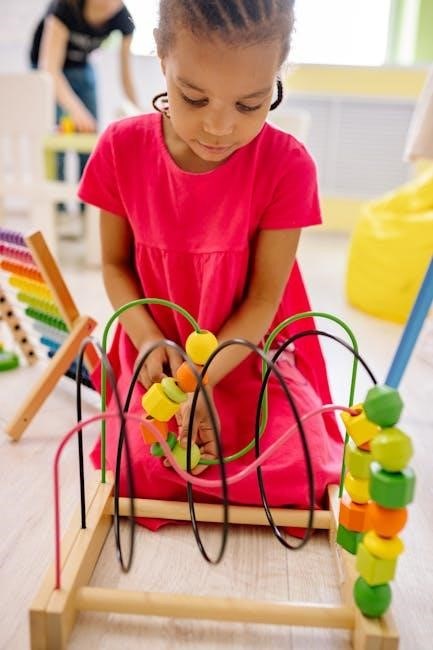
Language and Literacy
Language and literacy skills are foundational, focusing on listening, speaking, reading, and writing. Interactive activities foster vocabulary expansion, comprehension, and communication, preparing children for future academic success.
4.1 Phonics
Phonics instruction introduces children to the relationship between sounds and letters, laying the foundation for reading. Activities focus on recognizing beginning and ending sounds, rhyming, and blending sounds to form simple words. Teachers use engaging methods like songs, rhymes, and hands-on activities to help children decode and spell basic words, building essential skills for reading success in later years.
4.2 Reading Readiness
Reading readiness involves foundational skills that prepare children to decode and understand text. It includes print awareness, recognizing uppercase and lowercase letters, and understanding story structure. Teachers engage children with interactive stories, rhyming games, and group reading to foster a love for reading. Activities also include predicting story outcomes and identifying main ideas, building critical thinking while introducing the concept of reading as a source of enjoyment and learning.
4.3 Writing Skills
Writing skills in kindergarten focus on developing foundational abilities through playful and engaging activities. Children learn to trace and write their names, practice drawing shapes, and form simple letters. Teachers encourage creative writing by allowing children to express their thoughts through pictures and short sentences. Activities include using crayons, markers, and chalk to practice letter formation and storytelling. Interactive tools and hands-on exercises help build fine motor skills and confidence in writing.
4.4 Vocabulary Development
Vocabulary development in kindergarten is essential for building a strong foundation in language. Teachers introduce new words through stories, discussions, and interactive activities, helping children understand meanings and usage. Reading diverse books and encouraging conversations expand their word knowledge. This fosters critical thinking and communication skills, preparing them for future reading and academic success. Engaging activities ensure vocabulary growth is both enjoyable and effective.
Science and Exploration
Science and exploration in kindergarten foster curiosity and discovery. Children engage in hands-on activities, simple experiments, and nature-based learning to understand basic concepts and the world around them.
5.1 Basic Concepts
Kindergartners explore fundamental scientific ideas, such as day and night, seasons, and the five senses. These foundational concepts introduce children to the natural world and basic cycles, sparking curiosity and critical thinking. Hands-on activities and simple experiments help students grasp these ideas, fostering a love for science and encouraging them to ask questions about their environment. This early exposure builds a strong base for future learning and exploration.
5.2 Hands-On Activities
Hands-on activities in kindergarten science encourage children to explore, experiment, and discover concepts through interactive experiences. These activities, such as planting seeds, observing insects, or creating simple machines, foster curiosity and problem-solving skills. They allow children to engage with materials, make observations, and draw conclusions, fostering a deeper understanding of scientific principles while promoting creativity and collaboration.
5.3 Environmental Awareness
Environmental awareness in kindergarten introduces children to the importance of caring for the planet. Activities include recycling, planting trees, and learning about animal habitats. These experiences help children understand the interconnectedness of nature and human actions. Outdoor explorations and discussions about conservation foster a sense of responsibility and appreciation for the environment, laying the foundation for lifelong eco-friendly habits and respect for natural resources.
Arts and Creativity
Arts and creativity foster self-expression, imagination, and confidence in young learners. Activities include visual arts, music, and movement, encouraging children to explore and create freely.
6.1 Visual Arts
In kindergarten, visual arts encourage creativity and fine motor skills through drawing, painting, and crafting. Students explore colors, textures, and shapes using various materials like crayons, markers, and clay. These activities help develop self-expression and imagination while fostering an appreciation for art. Teachers guide children to experiment freely, building confidence and creativity. Art projects often align with other subjects, making learning interdisciplinary and engaging. This foundation prepares students to communicate ideas visually and understand artistic concepts.
6.2 Music and Movement
Music and movement in kindergarten foster creativity, coordination, and self-expression. Children engage in singsongs, rhythm activities, and simple instrument exploration to develop auditory skills. Movement activities, like dance and action games, enhance physical coordination and teamwork. These experiences promote emotional well-being and social interaction, encouraging children to explore their creativity while building foundational motor skills. Music and movement classes are integral to a holistic kindergarten education, nurturing both artistic and physical development in a playful environment.

Social Studies
Social studies introduce children to community, culture, and family roles, fostering awareness of traditions and social skills while sparking curiosity about the world around them.
7.1 Community Awareness
Community awareness in kindergarten helps children understand their role within society. Lessons focus on local helpers, community services, and cultural traditions. Field trips to libraries, parks, and fire stations introduce real-world connections. Activities encourage empathy and appreciation for diverse roles, fostering a sense of belonging. This foundation builds social responsibility and cooperation skills, preparing children to engage positively with their community.
7.2 Cultural Diversity
Cultural diversity in kindergarten fosters inclusivity and respect for differences. Activities highlight traditions, music, and art from various cultures, encouraging children to appreciate global perspectives. Storytime features books representing diverse families and backgrounds. Teachers incorporate diverse holidays and customs, promoting empathy and understanding. This exposure helps children develop open-mindedness and a sense of belonging in a multicultural world, preparing them to collaborate with people from all backgrounds.
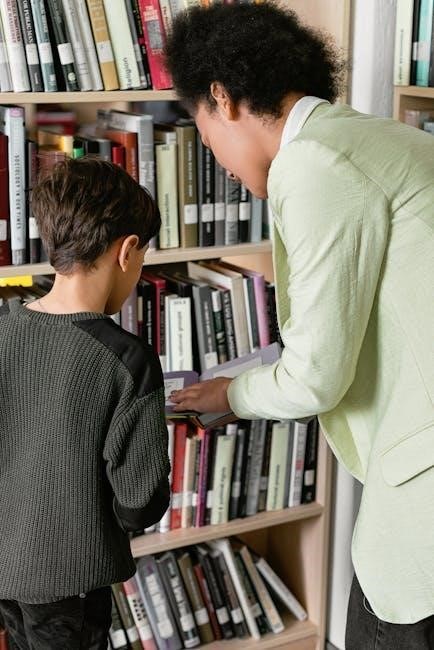
Physical Development
Physical development in kindergarten focuses on improving gross and fine motor skills through play, sports, and hands-on activities, fostering coordination, balance, and overall physical health in children.
8.1 Gross Motor Skills
Gross motor skills in kindergarten focus on large muscle groups, enhancing coordination, balance, and overall physical fitness. Activities include running, jumping, throwing, and climbing, promoting strength and agility. Play-based learning encourages movement exploration, while structured games improve teamwork and spatial awareness. These skills lay the foundation for more complex movements, preparing children for physical activities in later years and fostering lifelong health and well-being through active play and engagement.
8.2 Fine Motor Skills
Fine motor skills in kindergarten focus on refining small muscle movements, particularly in hands and fingers. Activities like puzzles, coloring, and using manipulatives enhance dexterity and hand-eye coordination. Play with playdough, cutting with scissors, and tracing shapes are common exercises. These skills are essential for tasks like writing, drawing, and using tools, preparing children for more complex academic activities while fostering creativity and precision in their daily interactions with objects.
Technology Integration
Technology integration in kindergarten introduces basic digital tools, fostering interactive learning through educational apps, games, and digital whiteboards to enhance problem-solving and creativity while ensuring safety.
9.1 Educational Tools
Educational tools in kindergarten technology integration include interactive whiteboards, tablets, and learning apps. These tools engage young learners, promoting problem-solving and creativity. Apps are designed to align with curriculum goals, teaching shapes, colors, and basic math. Digital platforms also foster collaboration and independent learning. Teachers use these tools to track progress and adapt lessons. Safety features ensure secure and focused learning environments, preparing children for future tech-savvy classrooms. These tools make learning fun and accessible for all students.
9.2 Interactive Learning
Interactive learning in kindergarten involves hands-on activities that encourage engagement and participation. Group work, role-playing, and collaborative projects foster social skills and creativity. Teachers use storytelling, puppet shows, and sensory play to captivate young minds. These methods promote active thinking and problem-solving while catering to different learning styles. Interactive activities help children connect concepts to real-life experiences, making learning meaningful and enjoyable. This approach builds confidence and curiosity, laying a strong foundation for future academic success.

Parental Involvement
Parental involvement fosters a collaborative learning environment, enhancing a child’s academic and emotional growth through active participation and support from home.
10.1 Supporting at Home
Parents play a vital role in reinforcing kindergarten learning by creating a supportive home environment. Establishing routines for homework and reading fosters consistency. Providing access to educational resources and materials encourages curiosity and exploration. Encouraging open communication about daily activities helps children reflect on their learning. Positive reinforcement and celebration of milestones build confidence and motivation. Collaborating with teachers to align home activities with classroom goals ensures a cohesive educational experience.
10.2 Communication with Teachers
Regular communication with teachers is essential for a child’s success in kindergarten. Parents should attend parent-teacher conferences, ask questions, and share concerns. Teachers provide updates on progress, strengths, and areas needing support. Using digital tools or notes for daily updates ensures consistent dialogue. Collaboration between parents and teachers fosters a unified approach to education, helping children thrive academically and socially. Open lines of communication build trust and ensure everyone is aligned in supporting the child’s growth.
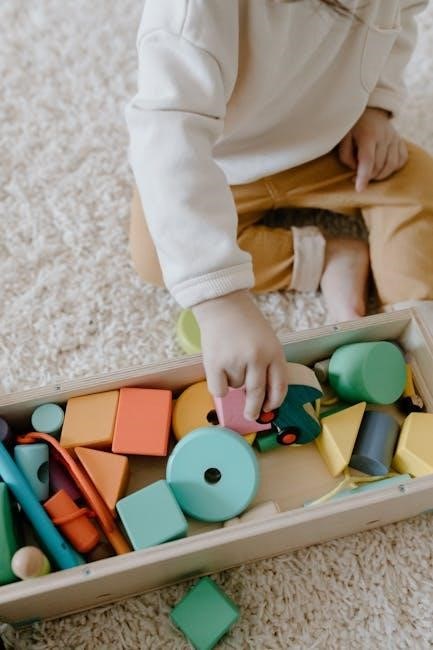
Accessibility and Inclusivity
Accessibility and inclusivity ensure all children can participate. Classrooms are adapted to meet diverse needs, with materials and strategies that promote equal learning opportunities for everyone.
11.1 Special Needs
Kindergarten programs accommodate children with special needs through individualized plans and support. Teachers use assistive technologies and adaptive materials to ensure inclusive learning. Classrooms are designed to be accessible, with flexible seating and sensory-friendly environments. Collaboration with specialists, like speech therapists, enhances tailored instruction. Activities are modified to meet diverse abilities, fostering participation and growth. The focus is on creating a supportive, inclusive space where every child can thrive and reach their potential.
11.2 Ontario Accessibility Standards
Kindergarten programs in Ontario adhere to accessibility standards, ensuring inclusive environments for all children. Classrooms are equipped with adaptive technologies and physical modifications, such as ramps and height-adjustable furniture. Policies promote equal access to learning materials and activities. These standards foster an inclusive culture, enabling children with diverse needs to participate fully and confidently. Compliance with accessibility laws ensures every child can thrive in a supportive and equitable educational setting.
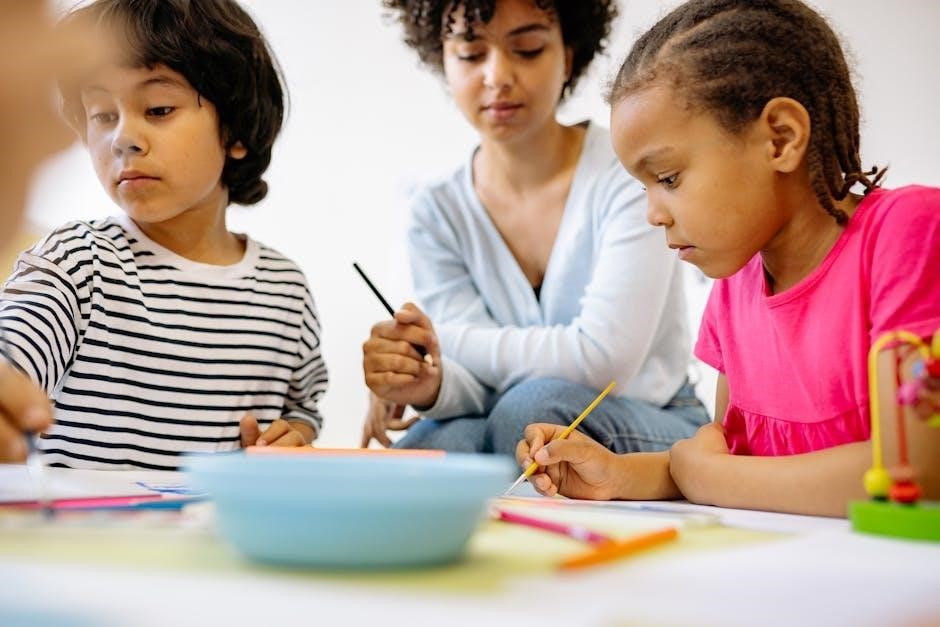
Homeschooling Kindergarten
Homeschooling kindergarten offers flexibility and personalized learning tailored to a child’s pace and interests. Parents can adapt the curriculum to suit their child’s unique needs and style.
12.1 Curriculum Choices
Homeschooling kindergarten allows parents to select curriculum tailored to their child’s learning style and interests. Choices include traditional, classical, or hands-on approaches, ensuring flexibility. Parents can opt for pre-designed programs or create personalized lesson plans, focusing on core subjects like math, reading, and social skills. Some incorporate STEM or Montessori methods, while others emphasize religious or cultural values. The ability to adapt curriculum to a child’s pace and strengths is a key advantage of homeschooling at this stage.
12.2 Schedules and Activities
Homeschooling kindergarten schedules are flexible, allowing parents to tailor activities to their child’s pace and interests. Days often include short, engaging sessions in reading, math, and science, followed by outdoor play or creative projects. Hands-on activities like crafts and sensory play are emphasized to enhance learning and creativity. Regular breaks and physical activities ensure a balanced routine, promoting both academic and personal growth in a nurturing environment.
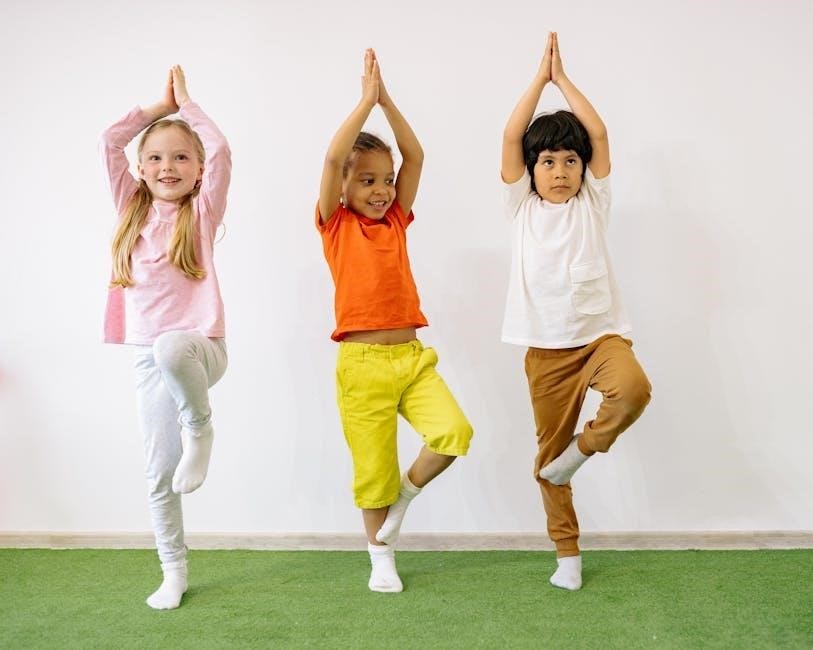
Assessment and Evaluation
Assessment in kindergarten focuses on observing children’s developmental milestones, identifying strengths, and areas needing support through play-based activities and progress tracking to guide instruction effectively.
13.1 Methods
Assessment methods in kindergarten include play-based observations, portfolio collections, and simple standardized tests tailored for young children. Teachers observe students during daily activities to evaluate social, emotional, and cognitive growth. Portfolios compile work samples, like art and writing, to track progress. Standardized tests focus on basic skills such as letter recognition or counting. These methods are engaging and stress-free, ensuring a comprehensive understanding of each child’s developmental stage and learning needs, while guiding instruction effectively.
13.2 Progress Monitoring
Progress monitoring in kindergarten involves regular, informal check-ins to track students’ growth. Teachers use tools like checklists, anecdotal records, and progress tracking sheets to document advancements. This ongoing process helps identify areas where children may need extra support or enrichment. By monitoring progress, educators can adjust instruction to meet individual needs, ensuring all students stay on track developmentally and academically throughout the year.

Kindergarten Readiness
Kindergarten readiness is a developmental milestone marking a child’s preparedness for formal education. It encompasses social, emotional, and cognitive skills that support future academic success.
14.1 Checklists
Kindergarten readiness checklists often include social, emotional, and cognitive skills. They assess abilities like independence, interaction with peers, and basic task completion. These tools help parents and educators identify areas where support may be needed; Common items include using the bathroom independently, recognizing shapes, and demonstrating curiosity. Checklists vary but generally focus on foundational skills that prepare children for structured learning environments. They are invaluable for ensuring a smooth transition into kindergarten.
14.2 Preparation Tips
Preparing for kindergarten involves establishing routines, fostering independence, and encouraging social interactions. Practice dressing, using the bathroom, and completing simple tasks independently. Engage in activities that promote literacy and numeracy, like reading and counting. Encourage curiosity and creativity through play. Provide emotional support by discussing expectations and reassuring your child. Collaborate with teachers to align home practices with classroom goals. These steps create a strong foundation for a successful transition into kindergarten.
A well-structured kindergarten curriculum fosters holistic development, preparing children for lifelong learning and growth. Early education lays a strong foundation for social, emotional, and academic success.
15.1 Recap
15.2 The Importance of Early Education
Early education is a cornerstone of child development, laying the foundation for future academic success and lifelong learning. It fosters cognitive growth, social skills, and emotional resilience, preparing children for formal schooling. Research shows that early learning experiences significantly impact a child’s ability to adapt and thrive. By nurturing curiosity and creativity, early education equips children with essential tools for overcoming challenges and achieving their full potential in an ever-evolving world.
